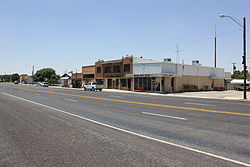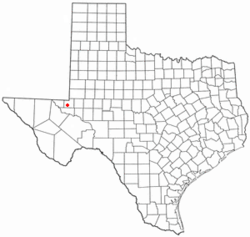Wink, Texas
| Wink, Texas | |
|---|---|
| City | |

Texas State Highway 115 in Wink
|
|
 Location of Wink, Texas |
|
 |
|
| Coordinates: 31°45′16″N 103°9′15″W / 31.75444°N 103.15417°WCoordinates: 31°45′16″N 103°9′15″W / 31.75444°N 103.15417°W | |
| Country | United States |
| State | Texas |
| County | Winkler |
| Area | |
| • Total | 1.2 sq mi (3 km2) |
| • Land | 1.2 sq mi (3 km2) |
| • Water | 0.0 sq mi (0 km2) |
| Elevation | 2,792 ft (851 m) |
| Population (2010) | |
| • Total | 940 |
| • Density | 780/sq mi (300/km2) |
| Time zone | Central (CST) (UTC-6) |
| • Summer (DST) | CDT (UTC-5) |
| ZIP code | 79789 |
| Area code(s) | 432 |
| FIPS code | 48-79768 |
| GNIS feature ID | 1371804 |
Wink is a city in Winkler County, Texas, United States. The population was 940 at the 2010 census.
Wink was a temporary childhood home to singer and songwriter Roy Orbison, although he was born in Vernon, Texas. Orbison would later describe the major components of life in Wink as "football, oil fields, oil, grease and sand", and in later years expressed relief that he was able to leave the desolate town.
Wink began in 1926, when oil was discovered in Hendrick oilfield in Winkler County. By mid-1927 the Wink Townsite Company was selling lots in Horse Wells pasture of the T. G. Hendrick Ranch. The oil boom brought new people to Wink, causing a shortage of housing. Newcomers set up tents and built makeshift houses. Wink was originally named Winkler, Texas for the county. When a post office was requested, postal authorities notified the applicant that there was a post office bearing that name already in operation. The citizens shortened the name to Wink and received a post office in 1927. In that year, the first public school was organized, and a temporary building was constructed. A Sunday school was started by November 1927, and the population of the town was reported at 3,500. By 1929 that number climbed to 6,000. It is possible the actual population would have been around 10,000 to 25,000 people.
The boom brought lawlessness to Wink, including bootlegging, prostitution, and gambling. Even the city government, which was organized on June 4, 1928, came under the control of a well-organized underworld. On October 16, 1928, District Judge Charles Klapproth declared the incorporation election void, and the city government was reorganized. In December 1928, the first municipal building, a jail, was constructed. In 1929 the Texas-New Mexico Railroad built its tracks from Wink Junction to Wink, connecting the town to Monahans and New Mexico.
In the 1930s the boom declined; the population hovered under 4,000, and the number of businesses fluctuated between 50 and 180. By 1933 the town was legally incorporated. Five hospitals and fifteen doctors served injured oilfield workers, expectant mothers, and epidemic victims. Throughout the 1940s the population continued to decline from 1,945 to 1,521, and the number of businesses decreased from 130 to 40.
...
Wikipedia
